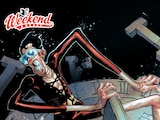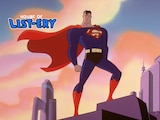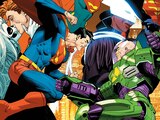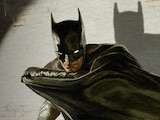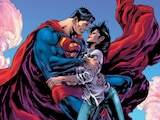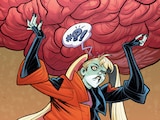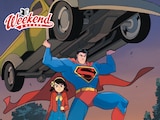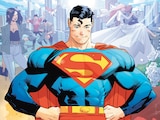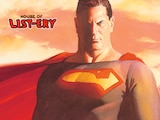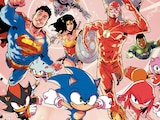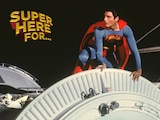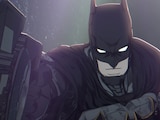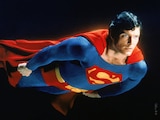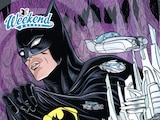The return of Elseworlds continues this week and this time, it’s bringing another figure from DC’s past along with it—the mystical Green Lantern first seen in the experimental Tangent Universe. Writer Tate Brombal (House of Slaughter) and artist Werther Dell’Edera use the 1997 Tangent event as a jumping off point for their original story, introducing a fiery new take on the character that’s thoroughly unlike any seen before. And with a monstrously undead Solomon Grundy as her nemesis, Green Lantern Dark #1 is the perfect comic for the Halloween season. We recently spoke to Brombal and Dell’Edera about this unique new series, how its protagonist is both similar and very different from the earlier Tangent Green Lantern and how dark this new Green Lantern tale will get. (It’s right there in the name, after all.)

Our new Green Lantern is named Rina Mori. What went into crafting and developing her?
Tate Brombal: The idea came from taking the very core of what a Green Lantern is—which is working with willpower—and combining that with someone who barely has the willpower to get out of bed in the morning. And she’s stuck with being the Green Lantern, as every other superhero in this universe is basically gone, and she has the weight of the apocalypse on her shoulders. The weight of living with that day by day, while the function of her powers is still willpower—that breaks you down over time. If you have no hope, but need it for willpower…that’s what the story is really about.
Everything hinges on that iconic power source and questioning whether Rina can even be the Green Lantern. We think this makes her relatable, and she’s not perfect. She doesn’t want to be the Green Lantern, which was fun to play with in terms of crafting emotional character arcs for her.
Werther Dell’Edera: When I came in, everything with the story was already set. But I was totally intrigued with this Elseworlds Green Lantern, which is very different. There are no other Green Lanterns, it’s more like the very first Green Lantern (Alan Scott) with magic powers. So that made me think of this as a large, incredible fantasy world. Another thing that intrigued me is how the Lantern’s power comes from a literal lantern. It brings to mind images of little moths flying around a lantern. So, I started to think about that image in designing her costume. The approach went from a leaf to an insect.

Your Green Lantern descends from the Tangent Green Lantern. How did that earlier character influence Rina?
TB: We wanted to come up with our own iconography with her. We wanted a new symbol to really separate her from the classic characters. She doesn’t have a power ring, her power doesn’t form in the shape of constructs—it works from literally a green flame.
This goes back to what Alan Scott’s powers were based on. They were more magic based than science fiction. He had a lantern that he wished upon and his wishes would come true. Rina has a lantern which produces a green flame, sometimes in the form of green moths. If you look at her cape, it’s almost in the shape of moth wings. And Werther gave her a lantern insignia on her chest. But to answer your question, we love the Tangent Green Lantern, and there’s definitely inspiration taken from her, but we really went for putting our own step towards our version of who this Green Lantern is supposed to be.

The title of this book is Green Lantern Dark, and you gentlemen both have a background in horror. Did that background inform the approach in coming up with this new GL story?
TB: I think a little bit. We do come from horror books, but we both really love levity and humor. We tried to balance out humor and heart with Rina’s struggle, so readers would fall in love with her and feel the weight of what she’s going through.
With this story taking place in a post-apocalyptic future, are we to assume that it was the result of any classic Green Lantern villains like Parallax, Sinestro, the Manhunters or anyone else familiar?
TB: I don’t want to spoil, and since it’s Elseworlds we’ll be doing some surprising twists on characters you’ve seen before. But the original Alan Scott villain was Solomon Grundy and we’re doing our version in this horror universe. Werther had a lot of fun designing him.
WD: We went back and forth on the original ideas, and how they’re a part of the nature of the apocalypse. It suggests The Last of Us—a creepy presentation of flowers. Grundy has a zombie army who has flowers and it’s really very fun.

What was the collaboration process, when it came to motifs like the flower and moth designs?
TB: It’s a world that’s fallen into darkness, and Rina is the only hope that’s still out there. At the very beginning of the scripting stage, Werther came up with the concept of light vs. darkness and how to bring that out. Not to mention the colors by Giovanna Niro which look really incredible.
You mention light vs. darkness. Does this mean this might be more of a hopeful story than a horror one?
TB: I think it’s both. I really love telling devastating stories which end with hope. The first issue is a journey. It’s scary and intense. But without spoiling anything, the Green Lantern embodies hope in the darkness.
Green Lantern Dark #1 by Tate Brombal, Werther Dell’Edera and Giovanna Niro is now available in print and as a digital comic book.

